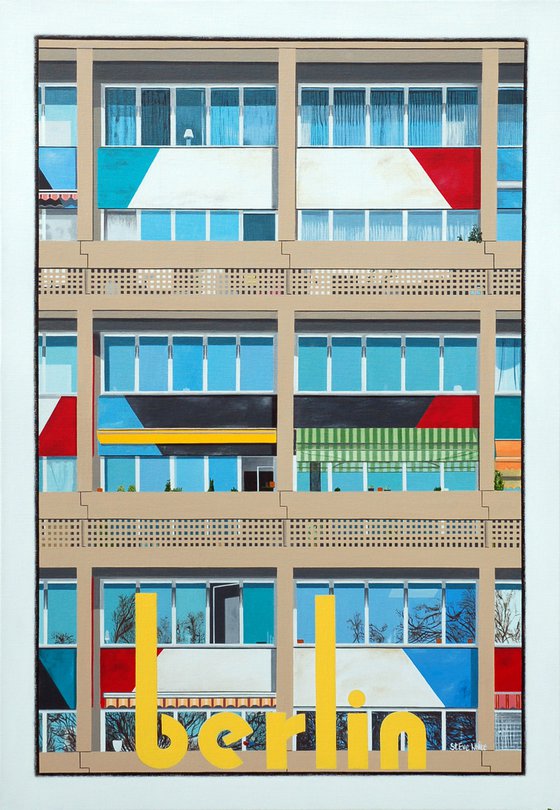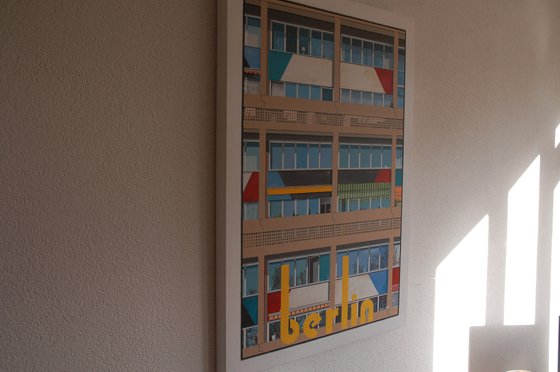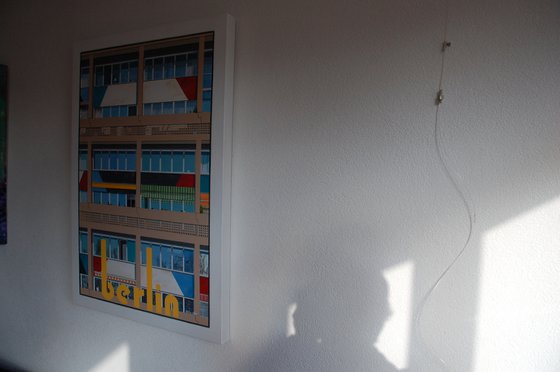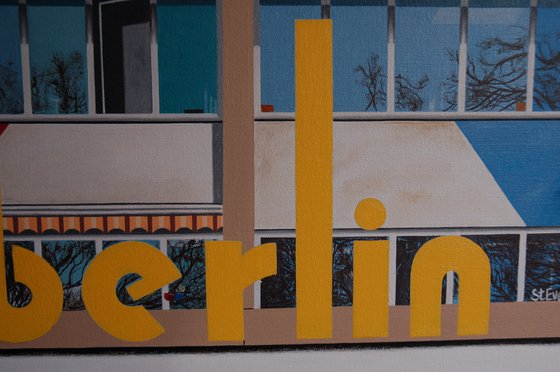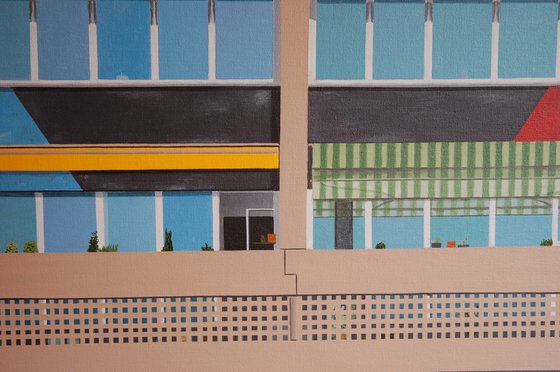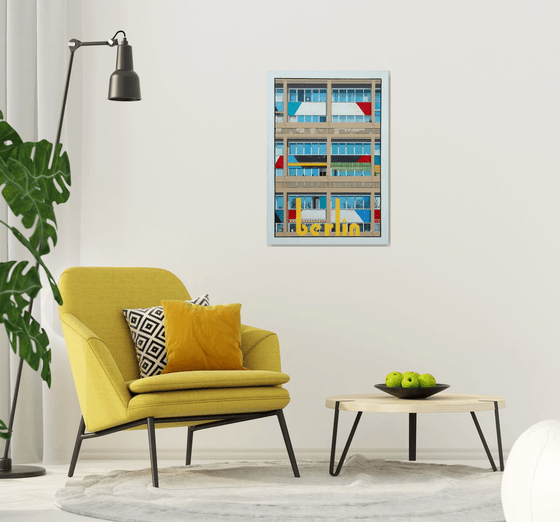Original artwork description:
I live 5 m below sea level in a Dutch new town built on reclaimed land. Someone has to.* The town is still under construction and situated on a prime site, overlooking a large lake, three grisly architectural abominations have risen from the silt like hideous creatures from the black lagoon. These grotesque buildings are so repellent to look at that they make my eyes bleed and my head explode whenever I see them. The 20 storey corrugated iron filing-cabinets-for-people make even the loathsome architectural style known as New Brutalism seem like Art Nouveau on a good day. Whilst walking around the lake recently, with the long shadow of these trashy towers burning into my retina like acid, I said to my wife, 'Why didn't they at least put just a little bit of colour in them?'
Le Corbusier is not the name Peugeot chose for it's latest SUV but was the nom de plume of the celebrated French/Swiss architect/artist/designer (real name Charles-Édouard Jeanneret, 1887-1965) best known for innovative buildings such as the modernist Villa Savoye in Poissy (1928-31); the UN building in New York (co-designed with Brazilian architect Oscar Niemeyer); and his infamous Chapel of Notre Dame Haut in Ronchamp (1950-55), a weird confection resembling a wedding cake wearing a bad wig. However Le Corbusier - 'I prefer drawing to talking. Drawing is faster, and leaves less room for lies' - was also heavily involved in the dull sounding world of urban planning. After Indian independence in 1947 he was invited by Indian Prime Minister Nehru to design the Indian city of Chandigarh, the capital city of the Punjab and Haryana States of India. Nice work if you can get it. And in the post war years he instigated his 'Unité d'habitation de Grande Conforme', a pompous sounding name for something which translates into 'housing units of a standard size.' Or, to put it another way, blocks of flats.
After the war West Berlin, isolated as it was in east Germany, watched enviously as East Berlin, with considerable help from the USSR, rapidly built much needed, high density affordable housing. In 1952 Le Corbusier had just completed his Unité in Marseille, arguably the most famous social housing project in the world, and was invited to submit plans for a site in the suburbs of west Berlin. The site chosen lay between the Olympic Stadium (of 1936 Jesse Owens fame) and a collosal pile of rubble, the ruins of the demolished city. Corbusier's idea was to "provide with silence and solitude before the sun, space and greenery, a dwelling which will be the perfect receptacle for the family", and to "set up, in God's good nature, under the sky and in the sun, a magisterial work of architecture, the product of rigour, grandeur, nobility, happiness and elegance".
Le Corbusier's grandiloquent claims for what essentially is a Brutalist block of flats (530 apartments on the 17 floors) are clearly hyperbolic. However I would have taken the merest hint of 'grandeur' 'nobility' 'happiness' 'elegance' or 'God's good nature' applied to the blocks of flats near where I live. It would have spared the world some gruesome grey silos looking like a geriatric steel works just before it is de-commissioned.
The colours of the exterior of Unité Berlin were designed by Corbusier together with the brilliant French painter Fernand Léger. The simple coloured panels with the diagonal slash are hardly artistically ground breaking but, together with the coloured awnings, they render the building much easier on the eye than an unremitting diet of beige cladding. Also on the inside of every balcony wall, unseen on this painting, are more vivid coloured panels. Living in the Unité Berlin saves you taking hallucinogenic drugs; living in the flats near my house would turn you on to them.
The moral of this story is summed up by the flamboyant American fashion/interior designer Iris Apfel who said: 'Colour can raise the dead.'
It ain't rocket science.
* This line is stolen from the first line of Bill Bryson's first mainstream book 'The Lost Continent: Travels in Small-Town America.' Thanks Bill!
Limited Edition Prints.
Printed on William Turner Hahnemuhle fine art exhibition quality paper (310 g/m2) using Epson Ultrachrome Pro Pigments, the colours remain true to the original up to 100 years.
The image size is 43×30 cms and there is an additional 3 cms border all the way round the image (ie total size: 49×36 cms). The artist will sign and number the print in this border. The print is unframed.
Prints will leave the artists studio within 7 days, rolled in a heavy tube, accompanied by a Certificate of Authenticity and sent via track and trace
UK Buyers Please Note: Since 1st Jan 2021 additional import taxes are being levied. In theory artworks should attract no more than a 5% charge but it seems to depend on the courier and could be more.
Materials used:
Acrylics
Tags:
#urban landscape #berlin #buildings and structures #poster artFeatured by our Editors:
Unité d'habitation, Berlin (2020)
Acrylic painting
by Steve White
1 Artist Reviews
£726.56 Sold
- Acrylic painting on Canvas
- One of a kind artwork
- Size: 70 x 100 x 4.5cm (unframed) / 70 x 100cm (actual image size)
- Ready to hang
- Signed on the front
- Style: Urban and Pop
- Subject: Architecture and cityscapes
Do you like this artwork?
This artwork has sold, but the artist is accepting commission requests. Commissioning an artwork is easy and you get a perfectly personalised piece.
Original artwork description
I live 5 m below sea level in a Dutch new town built on reclaimed land. Someone has to.* The town is still under construction and situated on a prime site, overlooking a large lake, three grisly architectural abominations have risen from the silt like hideous creatures from the black lagoon. These grotesque buildings are so repellent to look at that they make my eyes bleed and my head explode whenever I see them. The 20 storey corrugated iron filing-cabinets-for-people make even the loathsome architectural style known as New Brutalism seem like Art Nouveau on a good day. Whilst walking around the lake recently, with the long shadow of these trashy towers burning into my retina like acid, I said to my wife, 'Why didn't they at least put just a little bit of colour in them?'
Le Corbusier is not the name Peugeot chose for it's latest SUV but was the nom de plume of the celebrated French/Swiss architect/artist/designer (real name Charles-Édouard Jeanneret, 1887-1965) best known for innovative buildings such as the modernist Villa Savoye in Poissy (1928-31); the UN building in New York (co-designed with Brazilian architect Oscar Niemeyer); and his infamous Chapel of Notre Dame Haut in Ronchamp (1950-55), a weird confection resembling a wedding cake wearing a bad wig. However Le Corbusier - 'I prefer drawing to talking. Drawing is faster, and leaves less room for lies' - was also heavily involved in the dull sounding world of urban planning. After Indian independence in 1947 he was invited by Indian Prime Minister Nehru to design the Indian city of Chandigarh, the capital city of the Punjab and Haryana States of India. Nice work if you can get it. And in the post war years he instigated his 'Unité d'habitation de Grande Conforme', a pompous sounding name for something which translates into 'housing units of a standard size.' Or, to put it another way, blocks of flats.
After the war West Berlin, isolated as it was in east Germany, watched enviously as East Berlin, with considerable help from the USSR, rapidly built much needed, high density affordable housing. In 1952 Le Corbusier had just completed his Unité in Marseille, arguably the most famous social housing project in the world, and was invited to submit plans for a site in the suburbs of west Berlin. The site chosen lay between the Olympic Stadium (of 1936 Jesse Owens fame) and a collosal pile of rubble, the ruins of the demolished city. Corbusier's idea was to "provide with silence and solitude before the sun, space and greenery, a dwelling which will be the perfect receptacle for the family", and to "set up, in God's good nature, under the sky and in the sun, a magisterial work of architecture, the product of rigour, grandeur, nobility, happiness and elegance".
Le Corbusier's grandiloquent claims for what essentially is a Brutalist block of flats (530 apartments on the 17 floors) are clearly hyperbolic. However I would have taken the merest hint of 'grandeur' 'nobility' 'happiness' 'elegance' or 'God's good nature' applied to the blocks of flats near where I live. It would have spared the world some gruesome grey silos looking like a geriatric steel works just before it is de-commissioned.
The colours of the exterior of Unité Berlin were designed by Corbusier together with the brilliant French painter Fernand Léger. The simple coloured panels with the diagonal slash are hardly artistically ground breaking but, together with the coloured awnings, they render the building much easier on the eye than an unremitting diet of beige cladding. Also on the inside of every balcony wall, unseen on this painting, are more vivid coloured panels. Living in the Unité Berlin saves you taking hallucinogenic drugs; living in the flats near my house would turn you on to them.
The moral of this story is summed up by the flamboyant American fashion/interior designer Iris Apfel who said: 'Colour can raise the dead.'
It ain't rocket science.
* This line is stolen from the first line of Bill Bryson's first mainstream book 'The Lost Continent: Travels in Small-Town America.' Thanks Bill!
Limited Edition Prints.
Printed on William Turner Hahnemuhle fine art exhibition quality paper (310 g/m2) using Epson Ultrachrome Pro Pigments, the colours remain true to the original up to 100 years.
The image size is 43×30 cms and there is an additional 3 cms border all the way round the image (ie total size: 49×36 cms). The artist will sign and number the print in this border. The print is unframed.
Prints will leave the artists studio within 7 days, rolled in a heavy tube, accompanied by a Certificate of Authenticity and sent via track and trace
UK Buyers Please Note: Since 1st Jan 2021 additional import taxes are being levied. In theory artworks should attract no more than a 5% charge but it seems to depend on the courier and could be more.
Materials used:
Acrylics
Tags:
#urban landscape #berlin #buildings and structures #poster artFeatured by our Editors:
Returns and refunds
We want you to love your art! If you are not completely satisfied with your purchase you can return it free within 14 days, no questions asked. Learn more
Artist Reviews (1)
This artwork is sold by Steve White from Netherlands
